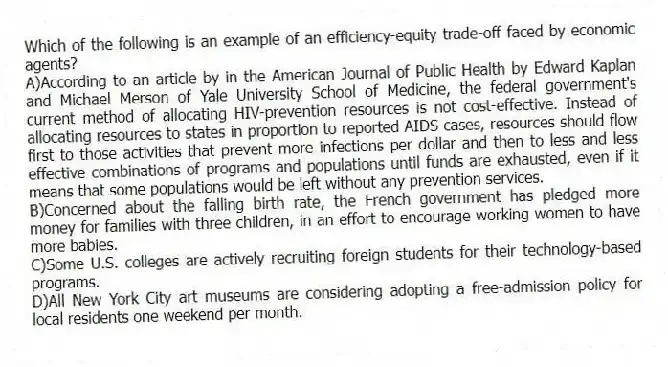
Which of the following is an example of an efficiency-equity trade-off faced by economic agents?
A) According to an article by in the American Journal of Public Health by Edward Kaplan and Michael Merson of Yale University School of Medicine, the federal government's current method of allocating HIV-prevention resources is not cost-effective. Instead of allocating resources to states in proportion to reported AIDS cases, resources should flow first to those activities that prevent more infections per dollar and then to less and less effective combinations of programs and populations until funds are exhausted, even if it means that some populations would be left without any prevention services.
B) Concerned about the falling birth rate, the French government has pledged more money for families with three children, in an effort to encourage working women to have more babies.
C) Some U.S. colleges are actively recruiting foreign students for their technology-based programs.
D) All New York City art museums are considering adopting a free-admission policy for local residents one weekend per month.
Correct Answer:
Verified
Q104: Allocative efficiency best explains _, and productive
Q105: In economics, the term "equity" means
A)everyone has
Q106: _ increases economic efficiency because it forces
Q107: Productive efficiency is achieved when
A)firms add a
Q108: Which of the following is motivated by
Q110: Which of the following is a result
Q111: Allocative efficiency is achieved when firms produce
Q112: Which of the following generates productive efficiency?
A)competition
Q113: Which of the following is motivated by
Q114: Which of the following is a problem
Unlock this Answer For Free Now!
View this answer and more for free by performing one of the following actions

Scan the QR code to install the App and get 2 free unlocks

Unlock quizzes for free by uploading documents